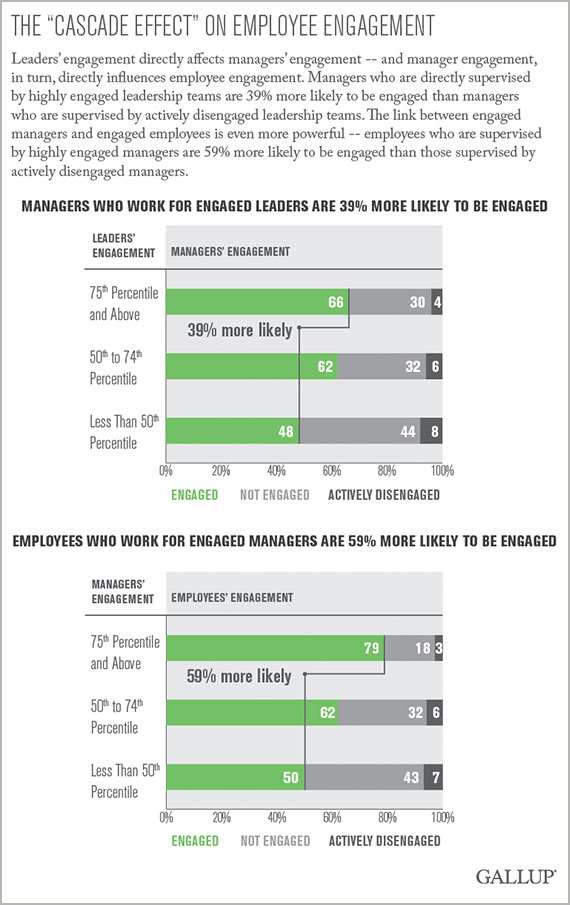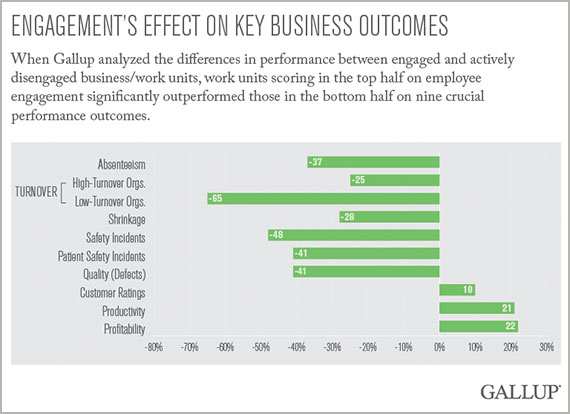Story Highlights
- 51% of managers are not engaged; 14% are actively disengaged
- Disengaged managers create disengaged employees
- Only 30% of U.S. workers are engaged
Managers have the greatest impact on employee engagement, which makes this finding very worrisome: A strikingly low percentage -- just 35% -- of U.S. managers are themselves engaged, while 51% are not engaged and 14% are actively disengaged.
By Gallup's estimates, the "not engaged" group costs the U.S. $77 billion to $96 billion annually through their impact on those they manage. And when we factor in the impact of the "actively disengaged" group, those figures jump to $319 billion to $398 billion annually.
Gallup's latest report, State of the American Manager: Analytics and Advice for Leaders, provides an in-depth look at how great managers inspire employees to become engaged -- and examines the impact of engagement on vital business outcomes, such as profitability and productivity.
The Cascade Effect
Day in and day out, managers are tasked with engaging employees, but 51% of managers have essentially "checked out," meaning they care little, if at all, about their job and company. And that attitude has dire consequences. A manager's engagement -- or lack thereof -- affects his or her employees' engagement, creating what Gallup calls the "cascade effect." Essentially, employees' engagement is directly influenced by their managers' engagement -- whose engagement is directly influenced by their managers' engagement.
Gallup has studied engagement data from 190 diverse industries and has found that managers who are directly supervised by highly engaged leadership teams are 39% more likely to be engaged than managers who are supervised by actively disengaged leadership teams. And the link between engaged managers and engaged employees is even more powerful. Employees who are supervised by highly engaged managers are 59% more likely to be engaged than those supervised by actively disengaged managers.

The Costs of an Apathetic Workforce
The percentage of engaged managers in the U.S. is alarmingly low -- and as predicted by the cascade effect, so is the percentage of engaged employees. Gallup's 2013 State of the American Workplace report revealed that 30% of U.S. workers are engaged, while 52% are not engaged and 18% are actively disengaged. The ratio of engaged to actively disengaged workers is roughly 2-to-1, and this distressing ratio has been stagnant for more than a decade.
These findings have serious consequences for the vitality of the U.S. economy. Gallup's research shows engagement is strongly connected to business outcomes that are essential to an organization's financial success, including productivity, profitability and customer ratings. And engaged employees are the ones who are the most likely to drive the innovation, growth and revenue that their companies desperately need. These engaged workers build new products and services, generate new ideas, create new customers and ultimately help spur the economy to create more good jobs.
Gallup measures engagement for employees at all levels using the Q12 survey, which consists of 12 items that link to performance outcomes. In 2012, Gallup' eighth Q12 meta-analysis confirmed the connection between employee engagement and nine business outcomes. Gallup researchers also analyzed the differences in performance between engaged and actively disengaged business/work units and found that those scoring in the top half on employee engagement nearly doubled their odds of success compared with those in the bottom half.

Reversing the Trend
Until organizations can increase their percentage of engaged managers, they have little hope of increasing their percentage of engaged employees. In our study of the cascade effect, Gallup has learned that certain Q12 items have the greatest potential to positively influence leader-to-manager engagement and manager-to-employee engagement. When leaders or managers score highly on these items, their direct reports are more likely to be engaged.
For leaders (defined by Gallup as executives), the Q12 items with the strongest connection to managers are:
- Q08. The mission or purpose of my company makes me feel my job is important.
- Q12. This last year, I have had opportunities at work to learn and grow.
For managers, the Q12 items with the strongest connection to employees are:
- Q03. At work, I have the opportunity to do what I do best every day.
- Q08. The mission or purpose of my company makes me feel my job is important.
According to Gallup's study of 2,564 managers, 40% or less "strongly agree" with the Q12 items listed above. Based on these findings, Gallup believes that leaders should invest in three critical actions to strengthen their managers' -- and subsequently, their employees' -- engagement and make the cascade effect work in their favor:
Clearly and consistently communicate where the organization has been and where it's going. Every leader, manager and employee wants to feel connected to his or her organization. People want to know what the company stands for and why, and to understand how their role supports the organization's overarching purpose and goals. Understanding their organization's mission or vision helps people see their job as more than just a job.
An organization's mission or purpose must be communicated from the top down. Leaders are responsible for setting these essential identity elements and ensuring that their managers understand what they mean and how to communicate them to employees. But leaders themselves are also responsible for living the company's mission or purpose and for being embodiments of the behaviors and attitudes they want to see in their managers and employees.
Make learning and development a priority. An individual's desire for learning never goes away, regardless of his or her title or position. Gallup research has discovered that people who get the opportunity to continually develop are twice as likely as those on the other end of the scale to say they will spend their career with their company. Leaders must make learning and development a priority for themselves and their managers, and they must take steps to create an environment where people have ongoing opportunities for personal improvement through formal coaching, group classes, mentoring or some other form of learning.
Emphasize managers' strengths. Organizations that hire managers based on their natural talents and then enable those people to turn their talents into strengths are better positioned for success. As part of this, leaders must equip their managers with the tools and resources necessary to identify and develop their individual strengths. But leaders must also understand their direct reports' strengths and know how those strengths play out in specific tasks and responsibilities. They should then mold managers' jobs to best allow them to make the most of those strengths. This approach helps increase the likelihood that managers will be internally motivated and engaged.

